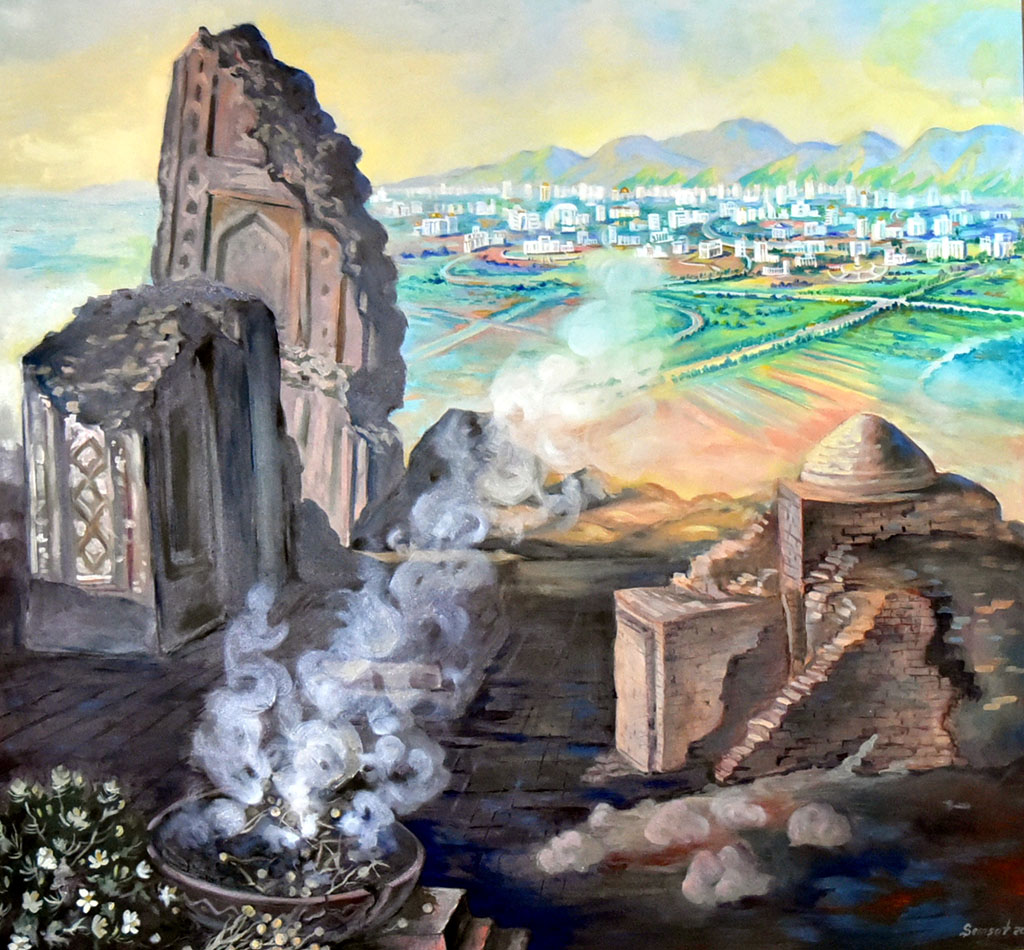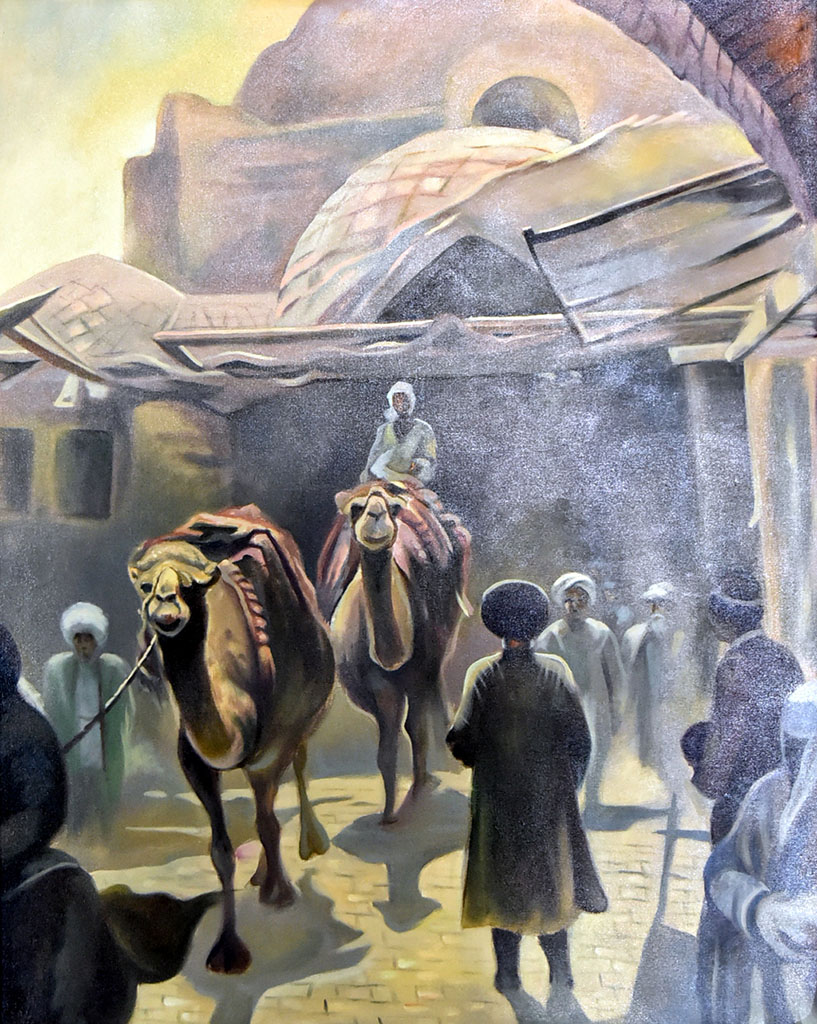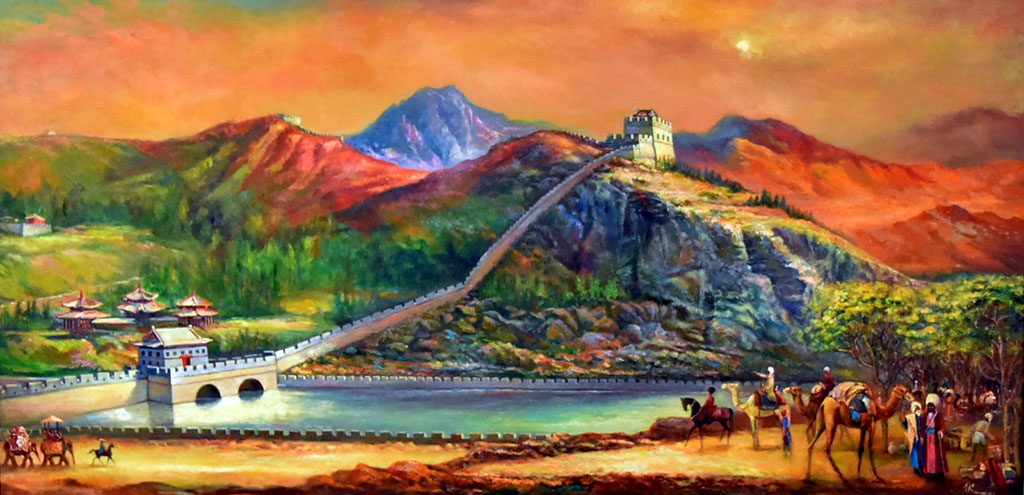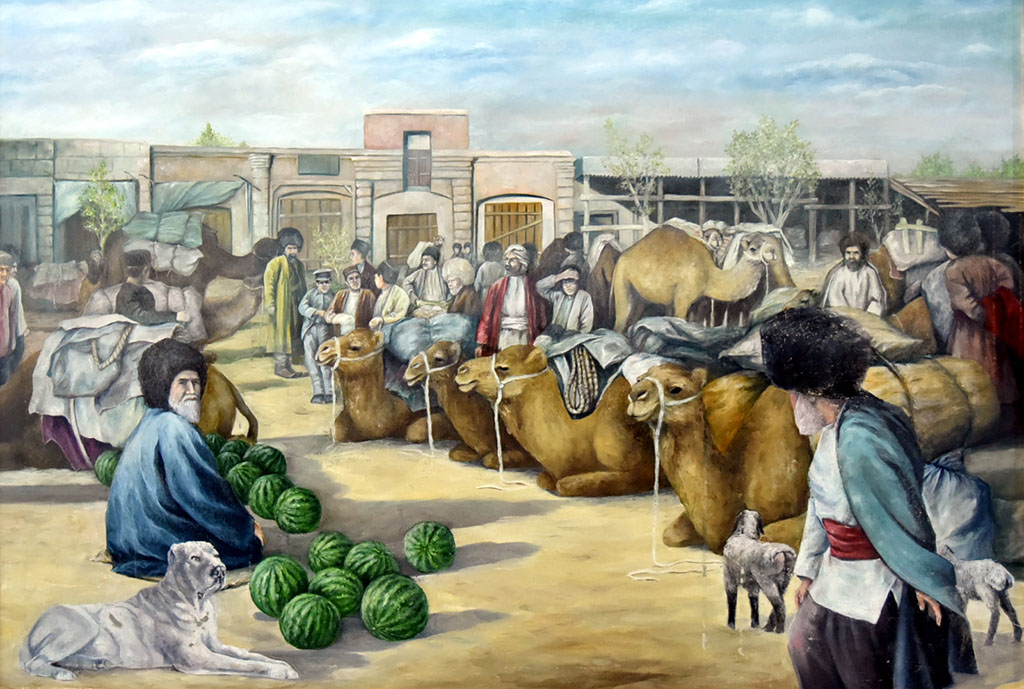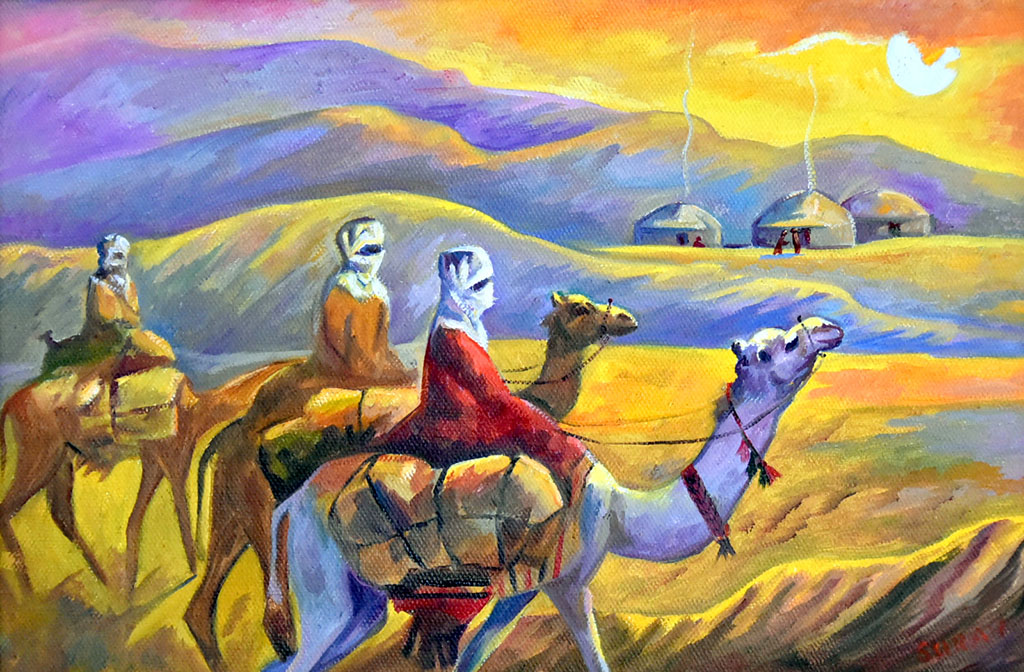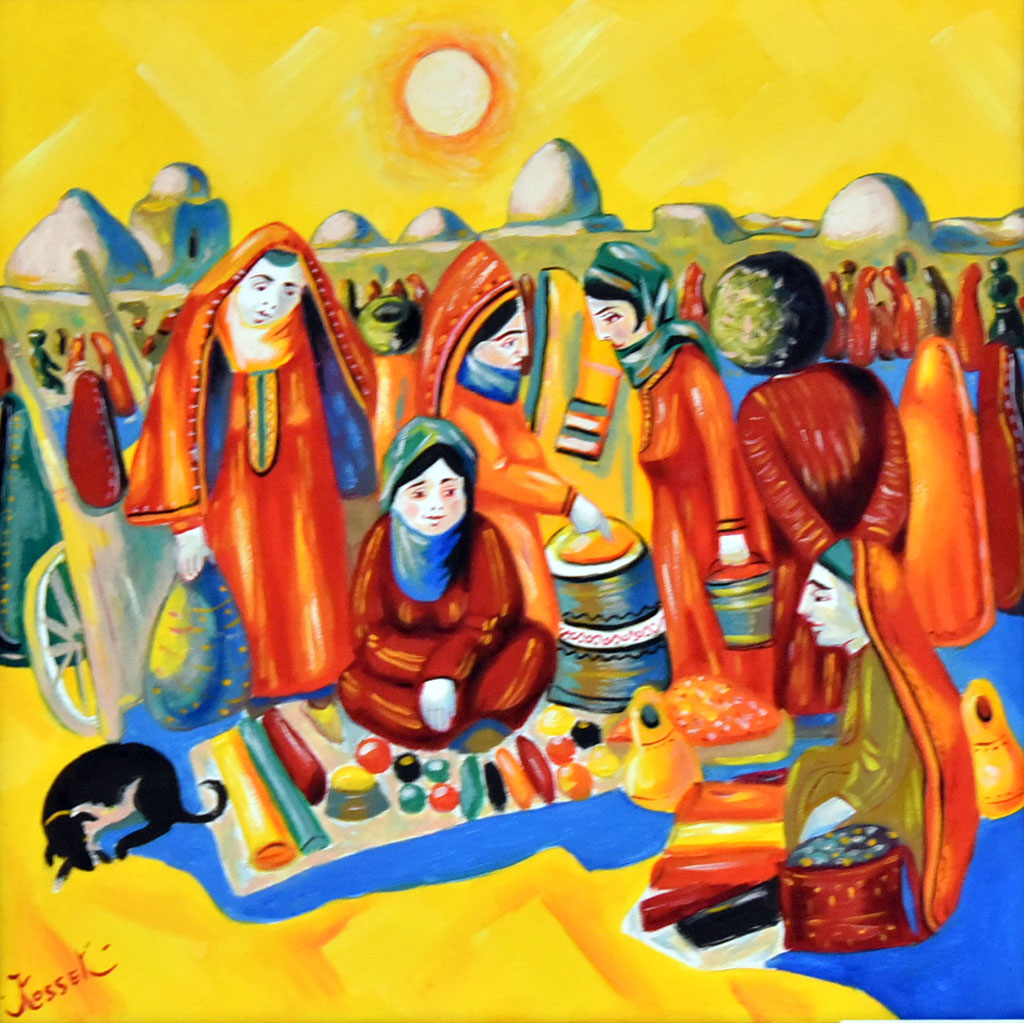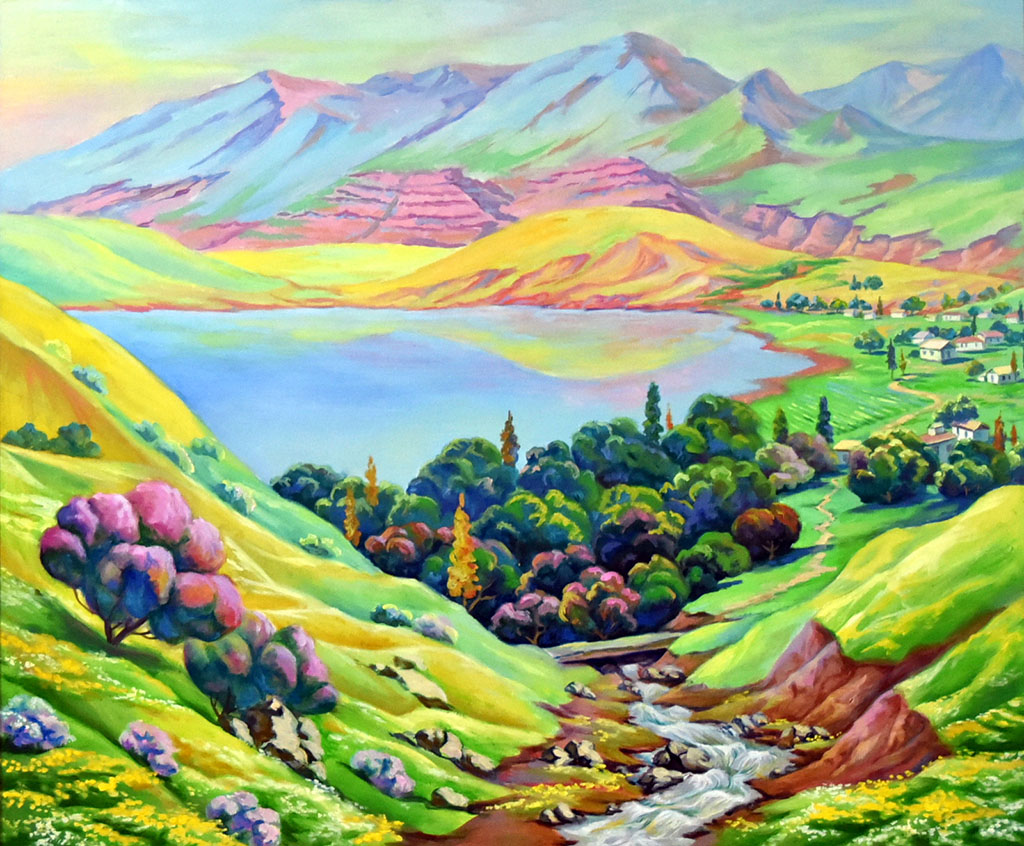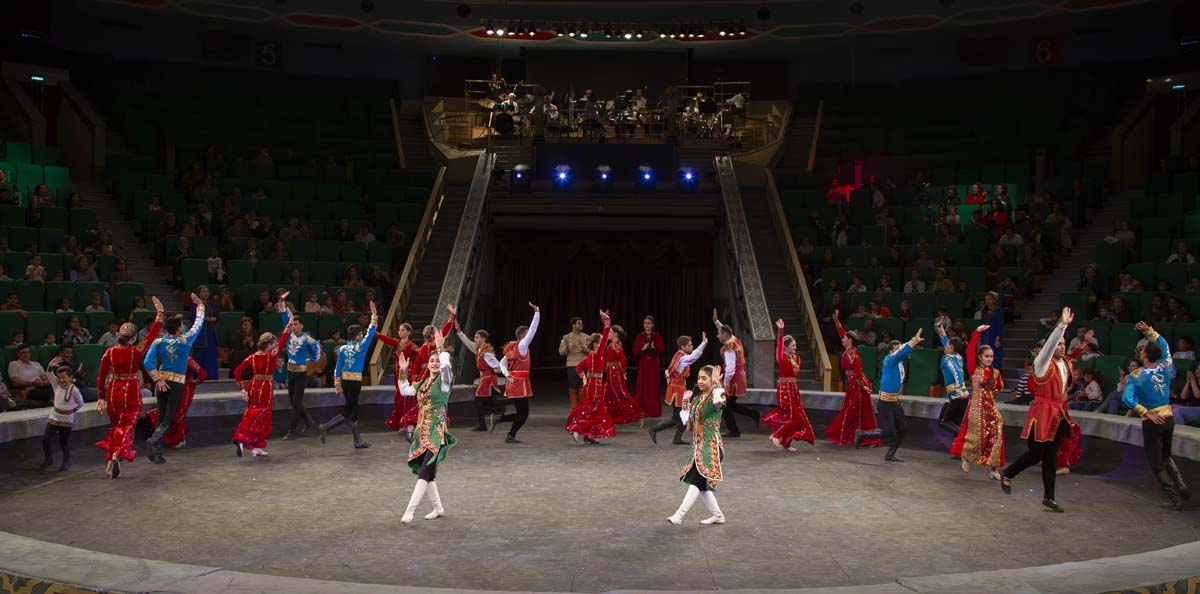The Great Silk Road does not cease to excite the imagination of researchers, writers and artists as a prototype of modern trans-Eurasian trade-economic and cultural bridges with its uniqueness. The works of painters, who, describing the bright events of history, evidence this, themselves become virtual participants in fascinating travels across countries and continents. They help the viewer feel the greatness of that time having captured his attention.
An exhibition of paintings by Turkmen artists dedicated to the Great Silk Road was opened in the capital's exhibition center. It is open by work of Shemshat Mammadova "Annau Mosque". On the canvas, Shemshat combined the past and the present with a glimpse of the magnificent panorama of the white marble Ashgabat from the symbolic pedestal of the historical and cultural heritage. The canvas opens a journey in ancient times, in which the Great Silk Road, according to the precise definition of the German explorer Ferdinand von Richthofen, was the archival event of the life of our great-great-grandfathers. Representatives of different countries came to the cities, bringing the shades of their original culture, enriching their perceptions of the world with relevant knowledge. There was an active interchange not only of goods, but also subtleties of handicraft production, political information, mental innovations.
The picture "Caravanserai" captures the moment of entry of caravans into one of the cities on the route. The author of the picture of Rejepberdi Muhammedov gave a respectful meeting to the residents of tired travelers. The painter was able to recreate the atmosphere of that era with its inherent customs and way of life. The heroes of the picture - both travelers and camels, are tired by the monotony of the long journey. The artist passed this state through the dominant gray color.
Caravaners often were gifted and educated people. They saw a lot on their way. As a rule, they spoke in several languages - without this, you cannot establish the necessary contacts. Among them were talented storytellers who passed on fascinating stories and legends to the local population, generously shared their impressions of the wonders of architecture, the diversity of the nature of other countries.
An artist Ishanguly Ishangulyev saw China as the caravaner in his work "Mountains of Qinhuangdao." He depicted a unique architectural structure - the Great Wall of China, stretched for many kilometers. In the right corner of the picture are the equestrians, admiring the picturesque landscape. Among them is the hero, whose impressions conveys the artist.
The same author in the painting "Nature of China" describes a mountain landscape with several solitary trees. The reddish color, heavily ruined rocks with its exotic appearance testify to the fact that they are Chinese, to match the rocks and steep bends of some Chinese trees growing. Ishanguly Ishangulyev noticed and transmitted the natural features of this country, as, for certain, many centuries ago, one of the caravaners, telling an amazing story about the people living here described the nature of this region.
Even the caravaners' travels through the countries located on the Great Silk Road were romantic, their main task was to trade. To be able to sell your product with profit is a talent that is not given to everyone. Caravaners were endowed with a commercial gift, and, traveling from city to city, from one country to another, they laid the foundations of economic diplomacy. Since ancient times the oriental bazaar has been the culmination in the life of artisans, farmers and pastoralists, bringing their goods for sale, as well as buyers who skillfully played on the balance of supply and demand. Two mutually complementary themes - the Great Silk Road and the Eastern Bazaar - are reflected in the canvases of the thematic exposition.
In the picture of Berdysahet Gurbansakhetov's "Old Teki Bazaar", we see a typical working day for traders offering their goods to buyers. Here we see a mountain of watermelons, their seller and his faithful friend - Alabai, as well as huge Khurdjuns with grain belonging to other sellers. Next to the merchants camels, as the main cargo vehicle of that time, and scurrying under their feet curious goats. In the communication of the seller and the buyer established certain traditions. For example, the first buyer could not be missed, otherwise the day was not expected to bring the profit. Therefore, the trader at times reduced the price as much as possible to interest, and necessarily gave with a surplus, thereby expressing his respect.
Conversation on the topic of the eastern bazaar is better to complete the work of Kosek Nurmuradov's "The Teke Bazaar”. We can see a saleswoman sitting on the rug of embroidery thread and another manufactory, which was surrounded by customers looking at the goods from all sides friends who broadcast the latest news about fellow villagers. In the eastern bazaar you can not only buy or sell something, but also meet old friends and find new ones ... In this regard, you keep in mind a wonderful series of works by People's Artist of Turkmenistan Shamukhamed Akmuhamedov "Sellers of Telpeks". The philosophy of the oriental bazaar, where communication takes the first place and the second is trade very good reflected in this work.
An exhibition of paintings by Turkmen artists dedicated to the Great Silk Road was opened in the capital's exhibition center. It is open by work of Shemshat Mammadova "Annau Mosque". On the canvas, Shemshat combined the past and the present with a glimpse of the magnificent panorama of the white marble Ashgabat from the symbolic pedestal of the historical and cultural heritage. The canvas opens a journey in ancient times, in which the Great Silk Road, according to the precise definition of the German explorer Ferdinand von Richthofen, was the archival event of the life of our great-great-grandfathers. Representatives of different countries came to the cities, bringing the shades of their original culture, enriching their perceptions of the world with relevant knowledge. There was an active interchange not only of goods, but also subtleties of handicraft production, political information, mental innovations.
The picture "Caravanserai" captures the moment of entry of caravans into one of the cities on the route. The author of the picture of Rejepberdi Muhammedov gave a respectful meeting to the residents of tired travelers. The painter was able to recreate the atmosphere of that era with its inherent customs and way of life. The heroes of the picture - both travelers and camels, are tired by the monotony of the long journey. The artist passed this state through the dominant gray color.
Caravaners often were gifted and educated people. They saw a lot on their way. As a rule, they spoke in several languages - without this, you cannot establish the necessary contacts. Among them were talented storytellers who passed on fascinating stories and legends to the local population, generously shared their impressions of the wonders of architecture, the diversity of the nature of other countries.
An artist Ishanguly Ishangulyev saw China as the caravaner in his work "Mountains of Qinhuangdao." He depicted a unique architectural structure - the Great Wall of China, stretched for many kilometers. In the right corner of the picture are the equestrians, admiring the picturesque landscape. Among them is the hero, whose impressions conveys the artist.
The same author in the painting "Nature of China" describes a mountain landscape with several solitary trees. The reddish color, heavily ruined rocks with its exotic appearance testify to the fact that they are Chinese, to match the rocks and steep bends of some Chinese trees growing. Ishanguly Ishangulyev noticed and transmitted the natural features of this country, as, for certain, many centuries ago, one of the caravaners, telling an amazing story about the people living here described the nature of this region.
Even the caravaners' travels through the countries located on the Great Silk Road were romantic, their main task was to trade. To be able to sell your product with profit is a talent that is not given to everyone. Caravaners were endowed with a commercial gift, and, traveling from city to city, from one country to another, they laid the foundations of economic diplomacy. Since ancient times the oriental bazaar has been the culmination in the life of artisans, farmers and pastoralists, bringing their goods for sale, as well as buyers who skillfully played on the balance of supply and demand. Two mutually complementary themes - the Great Silk Road and the Eastern Bazaar - are reflected in the canvases of the thematic exposition.
In the picture of Berdysahet Gurbansakhetov's "Old Teki Bazaar", we see a typical working day for traders offering their goods to buyers. Here we see a mountain of watermelons, their seller and his faithful friend - Alabai, as well as huge Khurdjuns with grain belonging to other sellers. Next to the merchants camels, as the main cargo vehicle of that time, and scurrying under their feet curious goats. In the communication of the seller and the buyer established certain traditions. For example, the first buyer could not be missed, otherwise the day was not expected to bring the profit. Therefore, the trader at times reduced the price as much as possible to interest, and necessarily gave with a surplus, thereby expressing his respect.
Conversation on the topic of the eastern bazaar is better to complete the work of Kosek Nurmuradov's "The Teke Bazaar”. We can see a saleswoman sitting on the rug of embroidery thread and another manufactory, which was surrounded by customers looking at the goods from all sides friends who broadcast the latest news about fellow villagers. In the eastern bazaar you can not only buy or sell something, but also meet old friends and find new ones ... In this regard, you keep in mind a wonderful series of works by People's Artist of Turkmenistan Shamukhamed Akmuhamedov "Sellers of Telpeks". The philosophy of the oriental bazaar, where communication takes the first place and the second is trade very good reflected in this work.




